Eco-friendly and efficient, or expensive and unnecessary – how electronic price labels change stores

According to the latest analysis, the global market for electronic price labels (ESLs) is growing rapidly, with $1.2 billion in 2023 expected to grow to $3.5 billion by 20311. Electronic price labels aren’t just digital displays of product cost – they’re a technological revolution changing how you manage pricing, operations, and customer interaction. What specific benefits do they bring to retailers? Exorigo-Upos and AQUILA DYNAMICS experts explain.
Electronic price labels are used in retail stores to display product prices on shelves. Instead of traditional paper tags, digital screens are used – most often e-ink (similar to those used in e-book readers) or LCD. The labels are integrated with the store’s price management system and warehouse, connecting via Wi-Fi, Bluetooth or NFC. This allows the product’s value on the shelf to change in real-time, eliminating the need for manual label changes and minimizing the risk of errors.
In the UK, they were implemented in the Robert Dyas chain of stores over 20 years ago. In our country, one of the pioneers of this type of implementation was the Tesco chain, which tested this solution over a decade ago. In the second half of 2023, Lidl completed the process of installing electronic price markings in all its stores – the first tests were carried out in 2022, and their success accelerated further implementation. The Biedronka chain, on the other hand, has announced that it plans to implement electronic price labels in all its outlets in 2025. They are also successfully used by Kaufland, Auchan and Żabka, noticing both operational convenience and environmental benefits resulting from reducing paper consumption.
Although electronic labels seem to be a solution available mainly to large retail chains in Poland, smaller stores abroad are also increasingly using this technology, which sees numerous benefits of its implementation.
– Electronic labels allow retailers to adjust prices quickly and react to subsequent changes in real-time. This is crucial in the price war environment, where the largest players are currently waging with each other. Time is very important in this case, and you cannot afford to make mistakes. Electronic price tags solve these problems, hence their growing popularity. Importantly, these solutions are available in various price ranges from manufacturers such as Hanshow, Vusion or Aquila Dynamics so that every retailer can find an option tailored to their needs. As an experienced ESL solution provider, we know very well how important the reliability and efficiency of these systems are. That is why we provide professional installation of electronic labels and comprehensive technical support, guaranteeing their efficient and error-free operation – says Piotr Sankiewicz, Business Development Manager at Exorigo-Upos.
Efficiency, cost savings and better customer experience
Electronic price labels allow you to instantly update prices for thousands of products with a single click, allowing retailers to adjust prices to meet demand, inventory levels, or market trends. This makes it possible to quickly respond to changes in the competition’s offer and implement personalised promotions for specific customer segments.
Importantly, automating this process significantly improves the efficiency of the staff, who no longer have to spend hours manually replacing paper tags. The traditional price update in large stores can take several days, and the risk of errors is high. ESL labels eliminate this problem by increasing the precision of price management and freeing employees to focus on tasks such as customer service or inventory management.
Electronic price tags also significantly improve the customer experience. The modern consumer expects transparency, accuracy and convenience when shopping. Thanks to real-time updates, he can be sure that the price on the shelf corresponds to the one at the checkout.
– It is worth noting the growing potential of this solution. After all, labels can display more than just the price. Integrating with technologies such as QR codes and NFC allows consumers to quickly access detailed product information, from nutritional values to organic certifications to reviews from other customers. This changes how you can shop, offering a consistent experience – says Michał Odzioba, Sales Manager at AQUILA DYNAMICS.
In addition to convenience and operational optimization, one key aspect of ESL price tags is their environmental impact. Traditional paper labels generate significant amounts of waste, while their electronic counterparts eliminate the use of paper, thereby reducing stores’ carbon footprint. Their long service life also makes them a greener and more economical solution in the long term.
ESL technology can also be part of a wider smart commerce ecosystem. It is increasingly combined with artificial intelligence systems that analyse sales data and recommend optimal pricing strategies. With Internet of Things (IoT) integration, they can monitor inventory levels in real-time, supporting warehouse management. In addition, electronic labels allow you to synchronise prices between brick-and-mortar stores and e-commerce platforms.
While the initial cost of implementing ESL price tags may seem high, the long-term savings from reducing labour costs, minimising pricing errors, and optimising inventory quickly make up for it. Combined with features such as dynamic pricing strategies and advanced analytics, this investment becomes a profitable step towards more effective and modern sales management.
Do you want to know the details of comprehensive pricing management? Contact us
1. https://www.openpr.com/news/3857226/electronic-shelf-labels-market-set-to-reach-3-5-billion-by-2031

